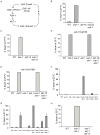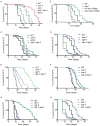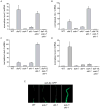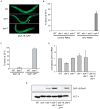EAK-7 controls development and life span by regulating nuclear DAF-16/FoxO activity
- PMID: 20620993
- PMCID: PMC2907918
- DOI: 10.1016/j.cmet.2010.05.004
EAK-7 controls development and life span by regulating nuclear DAF-16/FoxO activity
Abstract
FoxO transcription factors control development and longevity in diverse species. Although FoxO regulation via changes in its subcellular localization is well established, little is known about how FoxO activity is regulated in the nucleus. Here, we show that the conserved C. elegans protein EAK-7 acts in parallel to the serine/threonine kinase AKT-1 to inhibit the FoxO transcription factor DAF-16. Loss of EAK-7 activity promotes diapause and longevity in a DAF-16/FoxO-dependent manner. Whereas akt-1 mutation activates DAF-16/FoxO by promoting its translocation from the cytoplasm to the nucleus, eak-7 mutation increases nuclear DAF-16/FoxO activity without influencing DAF-16/FoxO subcellular localization. Thus, EAK-7 and AKT-1 inhibit DAF-16/FoxO activity via distinct mechanisms. Our results implicate EAK-7 as a FoxO regulator and highlight the biological impact of a regulatory pathway that governs the activity of nuclear FoxO without altering its subcellular location.
Copyright 2010 Elsevier Inc. All rights reserved.
Conflict of interest statement
The authors disclose no conflicts of interest with this study.
Figures







References
-
- Aamodt EJ, Chung MA, McGhee JD. Spatial control of gut-specific gene expression during Caenorhabditis elegans development. Science. 1991;252:579–582. - PubMed
-
- Accili D, Arden KC. FoxOs at the crossroads of cellular metabolism, differentiation, and transformation. Cell. 2004;117:421–426. - PubMed
-
- Apfeld J, Kenyon C. Cell nonautonomy of C. elegans daf-2 function in the regulation of diapause and life span. Cell. 1998;95:199–210. - PubMed
Publication types
MeSH terms
Substances
Grants and funding
LinkOut - more resources
Full Text Sources
Molecular Biology Databases
Research Materials
Miscellaneous

